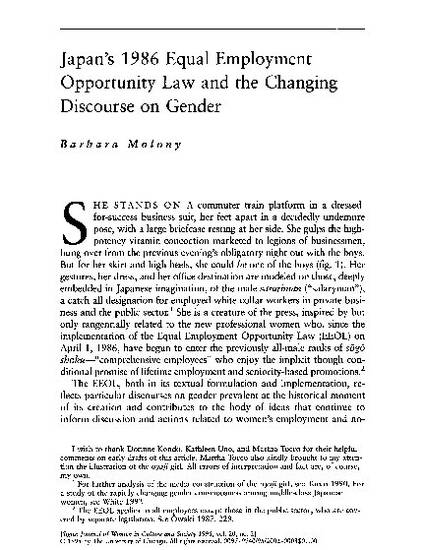
She stands on a commuter train platform in a dressed-for- success business suit, her feet apart in a decidedly undemure pose, with a large briefcase resting at her side. She gulps the highpotency vitamin concoction marketed to legions of businessmen, hung over from the previous evening's obligatory night out with the boys. But for her skirt and high heels, she could be one of the boys (fig. 1). Her gestures, her dress, and her office destination are modeled on those, deeply embedded in Japanese imagination, of the male sarariman ("salaryman"), a catch-all designation for employed white-collar workers in private business and the public sector. 1 She is a creature of the press, inspired by but only tangentially related to the new professional women who, since the implementation of the Equal Employment Opportunity Law (EEOL) on April 1, 1986, have begun to enter the previously all-male ranks of sogo shoku-"comprehensive employees" who enjoy the implicit though conditional promise of lifetime employment and seniority-based promotions.2 The EEOL, both in its textual formulation and implementation, reflects particular discourses on gender prevalent at the historical moment of its creation and contributes to the body of ideas that continue to inform discussion and actions related to women's employment and notions of gender. 3 In this article I will examine the intersection of gender and employment law, especially the EEOL, in four ways: first, I will discuss contemporary media images of women and men to suggest how the EEOL has affected gender discourse; second, I will analyze the changing meanings of motherhood and how motherhood as an inherent, gendered attribute is salient to both opponents and proponents of the EEOL; third, I will examine the political and consultative process by which the EEOL was brought into being; and fourth, I will interpret what the law means to employers, employees, and feminists in the years since its passage.

© 1995 by The University of Chicago Press. https://doi.org/10.1086/494975